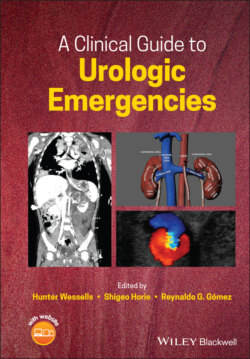Читать книгу A Clinical Guide to Urologic Emergencies - Группа авторов - Страница 27
Secondary Hemorrhage
ОглавлениеDelayed hemorrhage can be a life‐threatening complication of renal trauma that can arise as a result of the parenchymal injury itself, segmental arterial bleeding, or ruptured arteriovenous fistulas (AVFs) or pseudoaneurysm. One series of grade III–IV blunt injuries managed conservatively showed a 13–25% rate of delayed bleeds, with the caveats that this number varies significantly by series and the majority of the literature on delayed bleeds is derived from cases of penetrating trauma [83‐85]. Delayed bleeds occur most commonly in the first 2–3 weeks after trauma, although case reports have described trauma‐associated bleeds occurring as late as 15 or 20 years after the initial insult [83-84]. Renal trauma from stab wounds demonstrate the onset of secondary hemorrhage in the 2–36 day time‐frame [30, 85].
Most often, delayed hemorrhage is caused by AVF or pseudo‐aneurysm [30]. The occurrence of pseudoaneurysm after blunt renal trauma has been described in several case reports but is a rare event [83,86–88]. Pseudoaneurysms are believed to form within the surrounding tissue after an arterial injury, likely due to shear stress in blunt renal trauma, where the space around the vascular injury is temporarily tamponaded by coagulation. Eventually, the intravascular and extravascular space may recannulate after degradation of the clot and necrosis of the surrounding tissue, leading to the formation of a pseudoaneurysm which can then grow and rupture [88, 89].
AVF after blunt trauma is also a rare event and has been reported in several case reports [89–92]. The fistula is thought to form as a result of injury to an arterial and venous vessel in close proximity to one another, usually within the renal parenchyma. Initially the bleeding may be tamponaded by a clot; as the hematoma resorbs the arterial bleeding can resume, draining into the nearby lacerated vein [30].
New‐onset or worsening hematuria, flank pain or mass, a hematocrit drop, or even new‐onset hypertension, should raise suspicion of a delayed bleed. CT angiogram or conventional angiography is the preferred imaging modality, although diagnosis can be made with ultrasound in some cases. Depending on the etiology, either surgical management or super‐selective embolization is employed, with the goal of controlling the bleeding while preserving as much renal function as possible [93, 94]. Complications of embolization can include abscess, infarction, renal insufficiency, and pulmonary embolization of coils [25, 84, 94, 95].
